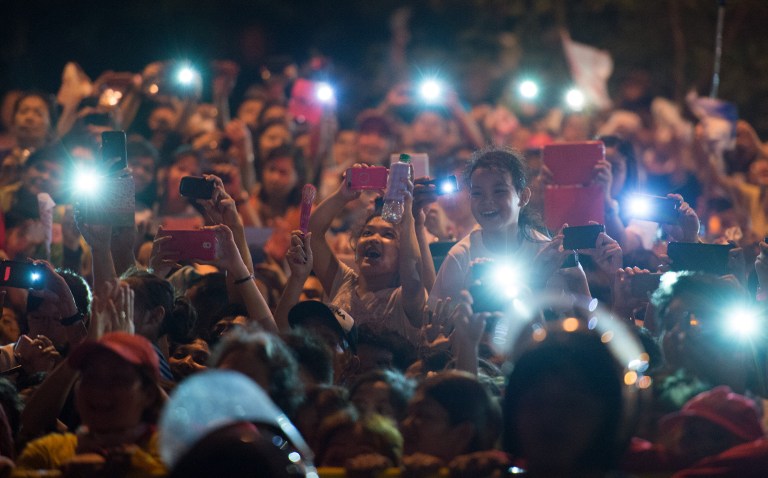
Well-wishers try to capture the arrival of Pope Francis using their mobile phones at his official residence in the Philippines in Manila on January 15, 2015. Pope Francis will immerse himself January 15 in the Catholic Church’s passionate and chaotic Asian heartland as he lands in the Philippines for a five-day trip that is tipped to attract a world-record papal crowd. AFP PHOTO / JOHANNES EISELE
About 70 million Filipinos or nearly 70 percent of the population are still not digitally connected.
This was bared Thursday during the DigitalBayanihan milestone update program of Intel Philippines at the Asian Institute of Management.
“While we see an increased adoption of digital devices in Southeast Asia and in the Philippines, there is still a growing gap in digital skills that needs to be addressed in order to fully take advantage of the benefits of the digital age,” said Prakash Mallya, Intel Southeast Asia managing director.
“If the 70 million unreached Filipinos can be digitally connected, they can change the landscape of the Philippines,” Mallya said.
In Southeast Asia, there are 374 million people who are not yet digitally connected, said Mallya, citing data from Intel.
Digital Inclusiveness
He said Intel is promoting digital connectivity to provide access and form a more productive Philippine society.
“We introduced DigitalBayanihan to promote digital inclusiveness in the country and empower Filipinos with access to digital skills training and devices,” he said.
Launched in September 2015, DigiBayanihan is Intel Philippines’ initiative that seeks to promote digital literacy through training, volunteerism and providing access to affordable technology.
From L-R: ASSIST founder and managing director Sreenivas Narayanan, FIT-ED senior program manager Sylvia Garde, TEVSAPHIL executive director Alex Mercado, NATCCO IT group head Evangeline Lopez, NATCCO president Sylvia Paraguya, Intel SEA managing director Prakash Mallya, Intel Philippines country manager Calum Chisholm, PSITE EVP John Ruero, Intel Philippines Business development manager Carlo Subido, Intel Philippines corporate affairs manager Yvonne Flores, and Intel Philippines marketing manager Randy Kanapi.
Together with 20 partner organizations and 4,000 volunteers, the program promotes the use of digital devices and services through comprehensive digital skills training.
Called “DigiBayanis,” the volunteers facilitate training and outreach initiatives that have touched 1,690,763 individuals and have listed 336,722 who have completed their training across the country this year.
The beneficiaries of the program learned how to use computers, digital devices such as tablets and smartphones, and how to the access the information available on the web.
DigiBayanihan targets to “touch” five million Filipinos and to fully equip one million individuals with information and communication technology (ICT) literacy.
Close the digital divide
For Intel Philippine country manager Calum Chrisholm, the DigiBayanihan is a journey for everyone.
“Every journey has a destination. Our destination is to close the digital divide, i.e., for everyone to be included in the Philippines. That is our shared goal,” Chrisholm said.
“DigiBayanihan is all about digital inclusiveness for everybody. All Filipinos should be included in digital literacy. It is also improving their connectivity. Their basic accessibility is an empowerment and development,” he added.
Partnering with organizations like Asia Society for Social Improvement and Sustainable Transformation (ASSIST), National Confederation of Cooperatives (NATCCO), Philippine Society of IT Educators (PSITE), and Technical Vocational Schools and Associations of the Philippines (TEVSAPHIL), Intel Philippines seeks to level up the program beyond the basic digital literacy skills.
NATCCO will offer financial literacy and livelihood programs through their network of cooperatives, while TEVSAPHIL will assist technical vocational schools in acquiring affordable devices.
Chrisholm said the program currently targets women, farmers, educators and students in the rural communities and even a school in Yolanda-hit Leyte.
He also lauded the Department of Science and Technology for providing free wifi access in remote communities in the country.
DigiBuy
Intel Philippines wants to level up its digital literacy initiatives by developing a platform where its beneficiaries can buy affordable devices.
DigiBayanis may own affordable devices through loans and special pricing from their respective organizations. Volunteers and their beneficiaries may also go to a special site on Lazada where they can buy specially-prized gadgets and devices whether for leisure or livelihood.
“The DigiBayanihan movement allows us to tap individuals who have limited to no access to digital devices. By introducing DigiBuy, these individuals have more opportunities to learn and apply their digital skills in their daily lives,” said Sreenivas Narayan, founder and managing director of ASSIST.
“We at Intel acknowledge the role of education and connectivity in empowering developing countries throughout the world. With Southeast Asia being a relatively young but strong region in terms of digital adoption, introducing programs that help promote and sustain digital literacy will help increase productivity and lay the foundation for a stronger digital economy,” said Mallya. Anthony Q. Esguerra/DM